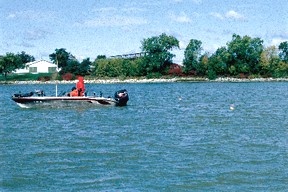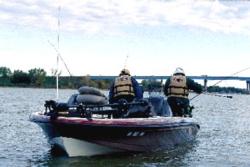Ways to wire a pattern

During the 2002 Walleye Tour event on Lake Winnebago, the brothers Glorvigen, twins Scott and Marty, made the challenging top-20 cut despite trolling crankbaits amid a small armada of competitors. The water was about 5 feet deep, but it was open water in that the walleyes were roaming, chasing one very specific sort of baitfish. The Glorvigens credit their success – eighth for Marty, 19th for Scott – to the ways in which they wired a pattern and how they adjusted to their, and the fishes’, environment. Some thoughts:
• Stagger line lengths behind planer boards in the most efficient manner to find out the equation that’s working. “When I change, I’ll change in the same increments,” Scott said. “That will help me figure out the pattern faster than anybody else.” All of which means that Scott will have each of his four lines at equal increments behind the boards. In shallow water, one is set 10 feet back, the next at 15, the following at 20 and the final at 25. (In clearer, deeper water, Glorvigen might go 20, 40, 60, 80.) When he resets the lines, he’ll try 15, 20, 25, 30.
• Recognize the prey-predator relationship. Although it was, in a way, frustrating to catch a constant parade of juvenile sheepshead while trolling crankbaits on Lake Poygan on the Winnebago chain, Marty Glorvigen compared his lure to the colors of the predominant prey. His most effective number was a blue Rapala Shad Rap with an orange belly that was darned near a dead ringer for the sheepshead’s hues.
“The biggest thing if you’re fishing the pack is to pay attention to details,” Marty said. “We were seeing the sheepshead on the surface, and the reality was the food chain was there. I knew that we were going to have to go through a lot of junk fish to get to the gamefish. I think the next explosion in angling information is the prey relationship. What does the prey do?”
• Respond to boating pressure. “When you’re trolling in a fair amount of boats and there is no particular structure to pin them down, we call it `wrangling,'” Scott said. “When you have a lot of boats, fish move to places the pressure is not.” It’s important, then, when trolling in a crowd to watch your surroundings and pull through an area where nobody has been for 15 or 20 minutes.
 • Try not to follow a “recipe” if it’s no longer working. Too often anglers get caught up in the trap of searching for a magic pattern. Don’t get caught up in catching the fish in exactly one way, even if it worked the day before or an hour or two earlier.
• Try not to follow a “recipe” if it’s no longer working. Too often anglers get caught up in the trap of searching for a magic pattern. Don’t get caught up in catching the fish in exactly one way, even if it worked the day before or an hour or two earlier.
“People don’t recognize what’s going on in their surroundings,” Marty said. “Look at everything around you. Are the fish on the surface? What’s the water clarity? Where has no one been?” In other words, keep changing to figure it out. A static pattern seldom pans out.
• Research seasonal migration patterns. On many waters such as Saginaw Bay, walleyes have been traveling in the same ways forever, perhaps for millennia. Information from the Department of Natural Resources, bait shops and locals can give an indication precisely what the travel routes are. For instance, on Saginaw, walleyes migrate at the start of summer from the Outer Bay southward into the Inner Bay. When you lose contact with them in such a scenario, you should already have an inclination which direction they’re going.
“When you’re trolling, you’re not often fishing the spot on the spot,” Scott said. “The fish are moving, and you have to be able to follow them. It helps to know ahead of time which way it will probably be.”